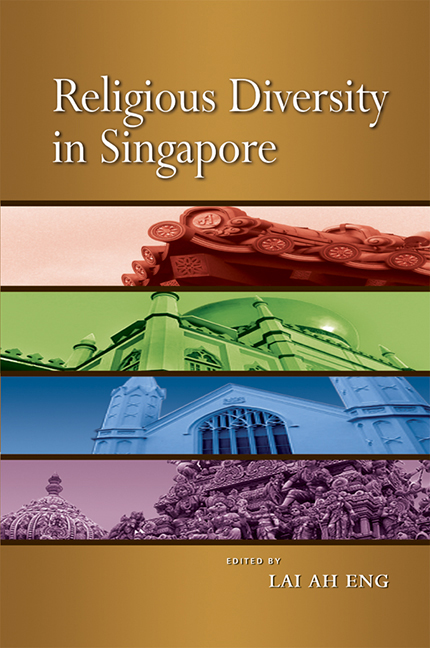Book contents
- Frontmatter
- Contents
- List of Figures and Tables
- List of Appendices
- FOREWORD
- PREFACE
- Acknowledgements
- The Contributors
- Abbreviations
- Glossary
- INTRODUCTION
- PART I The Landscape of Religious Diversity
- PART II Religion in Schools and Among the Young
- PART III Religion in the Media
- PART IV Religious Organizations in Social Services
- PART V Interfaith Issues and Interaction
- 23 Religious Diversity, Toleration and Interaction
- 24 Negotiating Christianity with Other Religions: The Views of Christian Clergymen in Singapore
- 25 The Inter-Religious Organization of Singapore
- 26 Interactions among Youth Leaders of Different Faiths: Realities from the Ground and Lessons Learnt
- 27 Building Bridges between Christians and Muslims: A Personal Journey
- 28 Conclusion: Some Remarks on Religious Diversity in Singapore
- Index
25 - The Inter-Religious Organization of Singapore
from PART V - Interfaith Issues and Interaction
Published online by Cambridge University Press: 21 October 2015
- Frontmatter
- Contents
- List of Figures and Tables
- List of Appendices
- FOREWORD
- PREFACE
- Acknowledgements
- The Contributors
- Abbreviations
- Glossary
- INTRODUCTION
- PART I The Landscape of Religious Diversity
- PART II Religion in Schools and Among the Young
- PART III Religion in the Media
- PART IV Religious Organizations in Social Services
- PART V Interfaith Issues and Interaction
- 23 Religious Diversity, Toleration and Interaction
- 24 Negotiating Christianity with Other Religions: The Views of Christian Clergymen in Singapore
- 25 The Inter-Religious Organization of Singapore
- 26 Interactions among Youth Leaders of Different Faiths: Realities from the Ground and Lessons Learnt
- 27 Building Bridges between Christians and Muslims: A Personal Journey
- 28 Conclusion: Some Remarks on Religious Diversity in Singapore
- Index
Summary
INTRODUCTION
Religious diversity, with its various forms, expressions and values of individual religions, inevitably raises aspects and issues of inter-religious interaction and relations and the formal and informal structures and processes through which these are conducted and negotiated. While exclusivism, separatism, avoidance or mere tolerance may be the approaches adopted by some individuals and groups to manage religious diversity, others see the promotion of interreligious understanding, dialogue and collaboration as desirable and the joint resolution of any religious tension and conflict that might arise as necessary for peace, accommodation and integration. While some focus on religious differences and their separatist or divisive tendencies, others emphasize similarities and commonalities and their unifying features and values.
In Singapore's history and social life, the inter-religious arena has on occasion surfaced overtly as a significant dimension and at other times remained latent as background context in ordinary and everyday life. At the broadest level, the state has defined religion (as well as race) as a sensitive area in which any religious expression, interpretation and manipulation that it views as causing inter-religious tensions and threatening social harmony can be considered seditious and subject to its strong sanction. At the micro level, particularly for individuals, the “inter-religious” can be a direct and active experience, such as through proselytization, conversion, deliberative dialogue and selective influences; indirect encounters in daily social life such as within a residential locality, workplace or public space; or largely absent through deliberate avoidance or lifestyle choice. On the whole, beyond the gradual and selective processes of hybridization and syncretization in specific religions, such as in Chinese religions, and the deliberate attempts of proselytization and conversion, such as by some evangelical Christian groups, any “interreligious” activity, particularly of an organized form, has been largely limited; exclusivism, separatism, avoidance and tolerance largely characterise Singapore's multi-religious landscape.
The Inter-Religious Organization of Singapore (IRO) is an exceptional structure within that landscape. It is an expression of the belief held by individuals, representatives and constituencies of various faiths that the “inter-religious” is a necessary field of interaction and which requires ongoing joint attention, and that commonality is the basis for joint action. Set up in 1949, it has a long history of efforts at inter-religious activities.
- Type
- Chapter
- Information
- Religious Diversity in Singapore , pp. 605 - 641Publisher: ISEAS–Yusof Ishak InstitutePrint publication year: 2008

